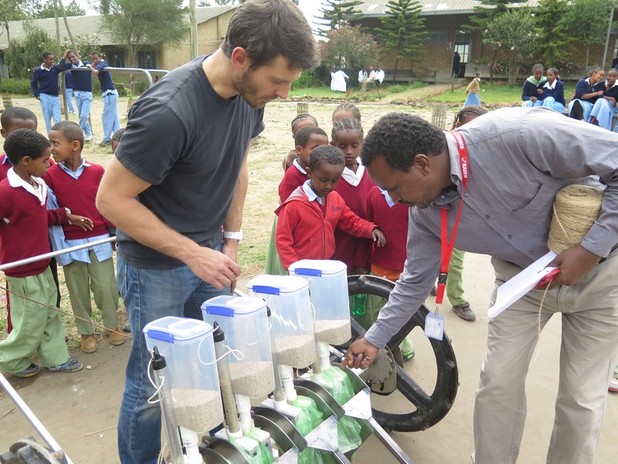April 07, 2014
Arriving in Ethiopia to present their prototype, Ravi and the Teff Mudders team experienced a few setbacks and learned the importance of having an agile project team.





While no one was thinking about teff row planters when coining the phrase “If anything can go wrong, it will go wrong,” it certainly applied to our device.
Our client, the Ethiopian Agricultural Transformation Agency (ATA), had been eagerly awaiting our arrival back to Ethiopia to see the planter we had been designing. Hopes were high and the pressure was on.
We arrived in Addis after a good 30 hours of travel time. Our crazy looking prototype got some strange looks in customs, but a little charm goes a long way. So far, so good. It was the morning, and we had a full day ahead of us to test our planter before presenting to the client the next day.
Our first test was what’s called a track test. We attached plastic bags to the planter to capture the teff and fertilizer and then pulled it over 100 meters of concrete. Then we measured the weight of the bags to determine if we had dispensed the proper amount of teff and fertilizer. We measured the seed bags and found that they were all spot on! Great news, this meant that our seed wheel was working perfectly. Now we just needed to measure the fertilizer bags and see that they were correct as well. That’s when things started going awry.
Each of the planter’s rows was dispensing WAY more fertilizer than they should have been. We were a bit surprised since this had worked perfectly back in San Francisco. We started coming up with theories as to why this was happening. Did we didn’t assemble the planter correctly? Was the fertilizer in the States a different size?
We ran the test again. This time, one of the units stopped dispensing fertilizer altogether. Then another. A third one sprung a leak and fertilizer was flowing from it like water. Our team could not figure out what was going on!
We were tired, demoralized, and a bit embarrassed. We were supposed to plant in the field the very next day, but everything with the fertilizer was going wrong and we didn’t have a good lead as to why. Daylight was fading, so we put the planter in the back of a pickup truck and started driving the 3 hours to our hotel. Then it happened. Rain. And lots of it.
Our planter is a functional prototype. While it looks like a planter and acts like a planter, it doesn’t have all the bells and whistles that a final product would have. Waterproof is something this prototype was not. Rain meant that we would have to painstakingly take apart the planter and dry every last nut and bolt before it could be used the next morning. Between that and trying to find a fix for the fertilizer, we prepared for a sleepless night.
While we didn’t know exactly why too much fertilizer was being dispensed, we went to work plugging up the holes. We then cleaned each piece and set it out to dry, hoping it would dry enough by the morning. We went to bed that night not knowing if the planter would be dry enough or if our fix would work.
When push comes to shove, we found out one important thing about our team and about prototyping in the field. It’s critical (and we were very lucky to have) an incredibly agile team able to deal with a myriad of obstacles being thrown in the way of success. Things will never quite go to plan. But being able to address these situations as they arise instead of throwing in the towel will make the learning experience that much richer.

